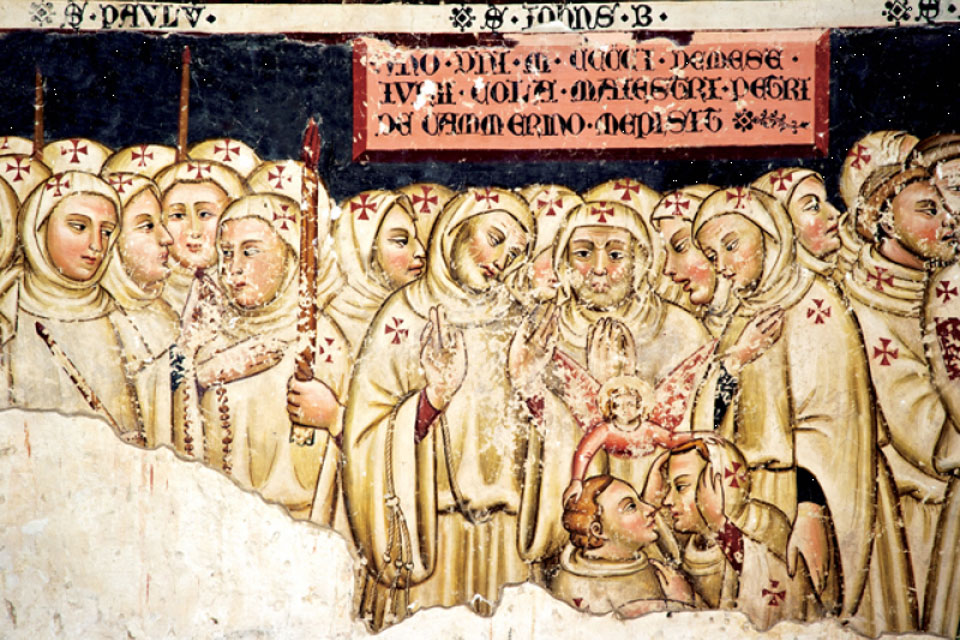New book explores how late medieval search for personal peace through regimens of penance, inspired the creation of a particular legal instrument to also obtain civic peace.

By Katherine Ludwig Jansen
Princeton University Press
In 1215 Messer Mazzingo Tegrini de’ Mazzinghi invited numerous Florentines of high rank to dine at his villa at Campi Bisenzio. During the festivities, a fight broke out between the jester and one of the guests, Messer Uberto degli Infanta, over a trencher of meat. Soon, this became a food fight, which rapidly evolved, when weapons were drawn. As it happened, a man, Buondelmonte stuck his knife into the arm of one Oddo, turning it into an altogether more dangerous situation. At a subsequent meeting, it was decided Buondelmonte should marry a niece of Oddo. He, however, had other plans and soon after engaged himself to another woman. Oddo, who was seriously insulted, consulted his allies. Subsequently, Buondelmonte was killed on Easter morning at the foot of Ponte Vecchio in front of the Amidei Palazzo in Florence.
Later, these shocking events – if they ever took place – led to the prolonged strife between the Guelfs, who supported Buondelmonte, and the Ghibellines, allies of Oddo Arrighi and the Fifanti. Arguably, the rivalry between these two parties – especially when aided and abetted by the local podestà – formed a particularly important aspect of the internal politics of Medieval Italy in the later Middle Ages. It persisted until the 15th century, although on quite another political level. While the Guelfs became known as the Papal party, the Ghibellines were known as the Imperial supporters. In the chronicles of that time – as well as in our historical imagination – we tend to focus on the many feuds and violent events, in which Florence and indeed the whole of Northern Italy was entrenched in this period. What we tend to forget is that the same history was permeated with a history of spectacular demographic, economic, religious and artistic growth on an unforeseen scale. One of the practical instruments furthering this parallel development was undoubtedly the “Instrumentum Pacis” or simply “pax”, a peace instrument, recording the settlement of disputes.
Developed in the crucible of the penitential peace movements led by laymen and friars at the turn of the 13th century, this legal instrument came to play a significant role in the formation of a well-ordered society in Florence as well as wider Northern Italy in the later Middle Ages.
In a new book, Katherine Ludwig Jansen demonstrates how “religious and political leaders used peace agreements for everything from bringing an end to neighbourhood quarrels to restoring full citizenship to judicial exiles. She brings to light a treasure trove of unpublished evidence from notarial archives and supports it with sermons, hagiography, political treatises, and chronicle accounts. She paints a vivid picture of life in an Italian commune, a socially and politically unstable world that strove to achieve peace. Jansen also assembles a wealth of visual material from the period, illustrating for the first time how the kiss of peace—a ritual gesture borrowed from the Catholic Mass—was incorporated into the settlement of secular disputes.
Breaking new ground in the study of peacemaking in the Middle Ages, Peace and Penance in Late Medieval Italy adds an entirely new dimension to our understanding of Italian culture in this turbulent age by showing how peace was conceived, memorialised, and occasionally achieved.”
Thus, even though Florence was entrenched in privately voiced enmities, factions as well as small and larger feuds, religiously inspired ideas of peace, ultimately stemming from the work of Augustine of Hippo, came to infuse society with the longing for civic peace at a more formal level. In this view, harmoniously aligned bodies and souls were expected to mirror “the heavenly tranquillity of order”. To obtain this state of bliss, anyone would, however, need to do penance to purge both body and soul. Eventually, this would not only lead to personal peace but also “civic peace”. Thus, peace instruments “with comforting similarities to confession and religious conciliation” also came to promote not only the personal but also the common good of peace.
ABOUT THE AUTHOR:
Katherine L. Jansen is Ordinary Professor and Department Chair at the Catholic University of America
FEATURED PHOTO:
Procession of the Bianchi. A penitentiary lay movements from 1399. Notice the Kiss of Peace at the bottom right. Mural from the Church of Santa Maria Assunta in the Vallo di Nera
